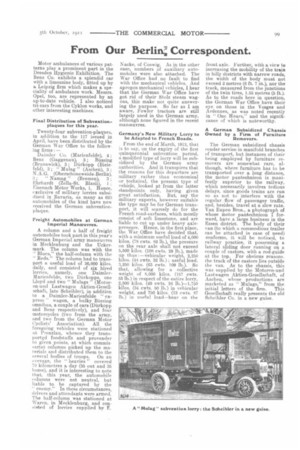From Our Berlin f.' Correspondent.
Page 17

If you've noticed an error in this article please click here to report it so we can fix it.
Motor ambulances of various patterns play a prominent part in the Dresden Hygienic Exhibition. The Benz Co. exhibits a splendid car with a limousine body, fitted up by a. Leipzig firm which makes a speciality of ambulance work. Messrs. Opel, too, are represented by an up-to-date vehicle. I also noticed tri-cars from the Cyklon works, and other interesting machines.
Final Distribution of Subventionplaques for this year.
Twenty-four subvention-plaques, in addition to the 117 issued in April, have been distributed by the German War Office to the following firms : —
Daimler Co. (Marienfelde), 4 ; Benz (Gaggenau), 3; Bussing (Brunswick), 3; Diirkopp (Bielefeld), 3; " Mulag " (Aschen), 3; N.A. G. (Oberscheneweide-Berlin), :1; " Namag " (Bremen), 3; Ehrhardt (Zella-St. Blasii), 1 ; Eisenach Motor Works, 1. Hence, exclusive of military lorries subsidised in Bavaria, as many as 622 automobiles of the kind have now received the German subventionplaque.
Freight Automobiles at German Imperial Manoeuvres.
A column and a half of freight automobiles took part in this year's German Imperial army manceuvres in Mecklenburg and the Uckermark. The column was with the " Blues," the half-column with the "Reds." The column had to transprzt a useful load of 36,000 kilos. daily, and consisted of six hired lorries, namely, one DaimlerMarienfelde, two Dtirkopps, one Lloyd and two " Mulags ' (Motoren-und Lastwagen Aktien-Gesellschaft, late Scheibler), in addition to a Daimler-Marienfelde " express " wagon, a bulky Bussing omnibus, a couple of cars (Diirkopp and Benz respectively), and four motorcycles (two from the army, and two from the German Motor Cyclists, Association). All the foregoing vehicles were stationed at Prenzlau, whence they transported foodstuffs and provender to given points, at which commissariat columns picked up the materials and distributed them to the several bodies of troops. On an average, the " heavies" covered 70 kilometres a day (35 out and 35 home), and it is interesting to note that, this year, the automobile columns were not neutral, but liable to be captured by the
enemy." In these circumstances, drivers and attendants were armed. The half-column was stationed at Waren, in Mecklenburg, and consisted of lorries supplied by E. Nacke, of Coswig. As in the other case, numbers of auxiliary automobiles were also attached. The War Office had no fault to find with the mechanical vehicles. And apropos mechanical vehicles, I hear that the German War Office have got rid of their Stolz steam wagons, this make not quite answering the purpose. So far as I am aware, Fowler tractors are still largely used in the German army, although none figured in the recent manceuvres.
Germany's New Military Lorry to be Adapted to French Roads.
From the end of March, 1913, that is to say, on the expiry of the first quinquennial subvention period, a modified type of lorry will be subsidised by the German army authorities. And it transpires that the reasons for this departure are military rather than economical or technical, the present type of vehicle, looked at. from the latter standpoints only, having given great satisfaction. But, say the military experts, however suitable the type may be for German transport, it will scarcely do for the French road-surfaces, which mostly consist of soft limestone, and are liable to cut up under heavy axlepressure. Hence, in the first place, the War Office have decided that, with a minimum useful load of 4,000 kilos. (78 cwts. 82 lb.), the pressure on the rear axle shall not exceed 5,500 kilos. (108 cwts. 29 lb.), made up thus : —vehicular weight, 2,250 kilos. (44 cwts. 32 lb.) ; useful load, 3,250 kilos. (63 cwts. 109 lb.). So that, allowing for a collective weight of 8,000 kilos. (157 cwts. 53 lb.) in respect of the entire lorry, 2,500 kilos. (49 cwts. 24 lb.)-1,750 kilos. (34 cwts. 50 lb.) in vehicular weight, and 750 kilos. (13 cwts. 87 lb.) in useful load—bear on the front axle. Further, with a view to increasing the mobility of the train in hilly districts with narrow roads, the width of the body must not exceed 2 metres (6 ft. 7 in.), nor the track, measured from the junctions of the twin tires, 1.55 metres (5 ft.). As to the roads here in question, the German War Office have their eye on those in the Vosges and Ardennes, as was noted recently in " One Hears," and the significance of which is noteworthy.
A German Subsidized Chassis Owned by a Firm of Furniture Removers.
The German subsidized chassis render service in manifold branches of transport, but instances of their being employed by furniture removers are somewhat rare, although, where furniture has to be transported over a long distance, the motor pantechnicon is manifestly superior to the railway, which necessarily involves tedious delays, since goods trains are run so as not to interfere with the regular flow of passenger traffic, and, besides, travel at a slow rate. Van Eupen Bros., a photograph of whose motor pantechnicon Iforward, have a large business in the Essen district. The body of their van (to which a commodious trailer can be attached in case of need) conforms, it will be notimd, to railway practice, it possessing a lateral sliding door running on a couple of castors, with a rod-guide at the top. For obvious reasons. the track of the castors lies outside the van. As to the chassis, this was supplied by the Motoren-und La st wagen Aktien-Gesellschaft, of Aachen, whose productions are marketed as " Mulags," from the
initial letters of the firm. This Gesellschaft really presents the old Scheibler Co. in a new guise.






















